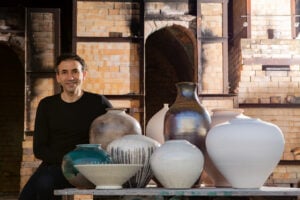 Tamer Zaki is an expert on turbulence and how fluids twist and whirl—when waves break on the ocean surface or the wind kicks up during a storm. But on evenings and weekends, this professor of mechanical engineering who studies the movement of air and water is immersed in another element—earth—as an accomplished potter. To Zaki, a lump of cool, wet clay is ripe with possibilities.
Tamer Zaki is an expert on turbulence and how fluids twist and whirl—when waves break on the ocean surface or the wind kicks up during a storm. But on evenings and weekends, this professor of mechanical engineering who studies the movement of air and water is immersed in another element—earth—as an accomplished potter. To Zaki, a lump of cool, wet clay is ripe with possibilities.
“Pottery fulfills a different and instinctive desire to build something tangible, or physical, to engage my tactile senses,” he says.
Zaki began working with clay in 1999 while a student in mechanical engineering at Penn State. He found pottery similar to the research process: You imagine something and proceed to create it.
 “It’s a journey from clay particles to a mound of clay on the wheel; from an imagined idea to a form; and, by fire, from greenware [water soluble] to bisque and all the way to a vitrified ware,” he says.
“It’s a journey from clay particles to a mound of clay on the wheel; from an imagined idea to a form; and, by fire, from greenware [water soluble] to bisque and all the way to a vitrified ware,” he says.
Zaki especially cherishes what he calls the “relationship” between potter and clay, which he shares with other ceramics enthusiasts by teaching classes at Baltimore Clayworks.
“You must be attuned to the clay during every stage of the process, making sure it has the right elasticity, consistency, and moisture. The feel tells you about its strength and how far you can stretch it. The material also has memory: On the wheel, it twists in a spiral imprinted by the potter’s hands and winds back as it dries. It’s thermally stressed when it’s fired, and some of that stress is relieved when cooled,” he says.




